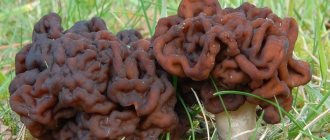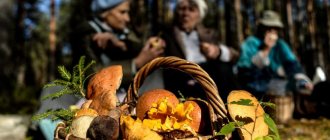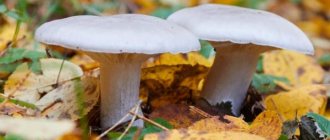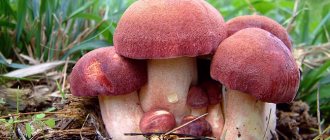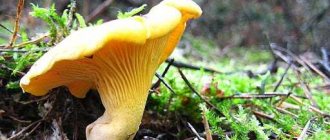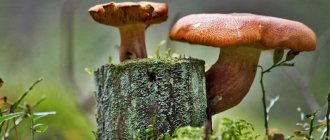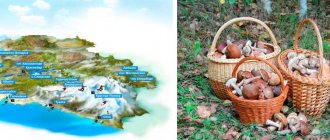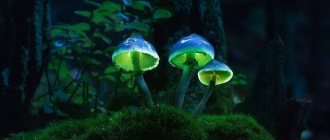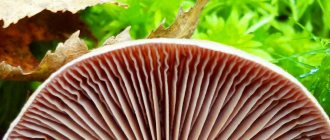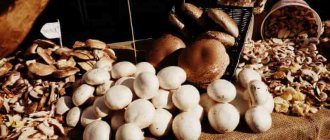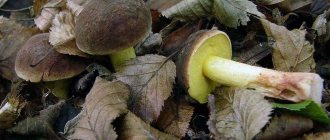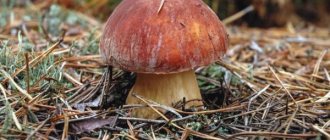Most connoisseurs of forest gifts do not miss the opportunity to harvest mushrooms such as oyster mushrooms. The crop has long been grown on an industrial scale and is often found on sale in city markets, but true mushroom pickers are convinced that only wild, forest oyster mushrooms have the brightest taste. And what kind of breadwinner would refuse the opportunity to personally feed his family with a fragrant delicacy?
Today we will talk about how to distinguish the fruits of a valuable mushroom and mushrooms similar to oyster mushrooms from each other. The information will be useful for beginning gatherers, as well as for those who value their own health when going into the forest for prey.
Can oyster mushrooms be poisonous?
Some mushroom pickers often wonder: do oyster mushrooms have poisonous counterparts? It is worth saying that poisonous mushrooms similar to oyster mushrooms do not grow in Russia. There are simply some types of fruiting bodies that are only similar to oyster mushrooms and are considered conditionally edible tree mushrooms, but they have a bitter taste. Simply put, poisonous oyster mushrooms do not grow on our territory. However, in the forest on trees you can often find a large number of mushrooms that are not oyster mushrooms. For example, scales or tinder fungi also resemble shelves and shells growing in layers.
All mushrooms growing on trees are called wood destroyers, since their mycelium develops in the middle of the wood, destroying its composition. If these mushrooms grow on dead trees, can oyster mushrooms be poisonous? It turns out that these fruiting bodies act as orderlies in the forest, turning dead wood into dust. If it were not for these mushrooms, the entire earth would be littered with dry tree trunks and branches, and there would be no nutrients left in the soil necessary for the growth of young trees. Under the influence of oyster mushrooms, dead wood is destroyed and turned into fertile soil.
Are there poisonous mushrooms similar to oyster mushrooms, and how to distinguish them?
Some mushroom pickers unfairly ignore oyster mushrooms, which hang beautifully from tree trunks. And some people simply don’t know how to distinguish oyster mushrooms from poisonous mushrooms.
So, are there poisonous mushrooms similar to oyster mushrooms? Let us remember that there is no poisonous analogue of oyster mushroom in our country. However, this does not mean that you can be careless about preparing these mushrooms. You can be poisoned by oyster mushrooms if you do not adhere to technological processes during processing. For example, if storage rules were not followed, or improper heat treatment was carried out. Oyster mushrooms can also be dangerous if collected near chemical plants or right next to highways.
Oyster mushroom, which has nothing in common with poisonous mushrooms, is widespread in our territory. Poisonous mushrooms similar to oyster mushrooms (see photo below) grow only in Australia.
However, you should always be aware that oyster mushrooms can be confused with some types of conditionally edible mushrooms found in the forests of Russia. These fruiting bodies are not poisonous, but they are not eaten because they taste bitter.
What poisonous mushrooms, similar to oyster mushrooms, are found in our forests? For example, orange oyster mushroom, although not considered poisonous, is not collected due to its excessive hardness and fluffy skin, so the mushroom is considered inedible. In the forest, orange oyster mushroom grows on the branches of birch, linden and aspen, on rotten stumps, tree trunks, and especially in dead wood. Like the oyster mushroom, this mushroom grows in large families, but is found very rarely. In the forest you can immediately notice it by its beautiful orange color. Usually, amateur gardeners buy orange oyster mushroom mycelium and grow it as a decoration for the garden.
There is another type of mushroom, similar to oyster mushrooms, but not poisonous, but simply inedible - this is wolf sawfolium. It is not eaten because of its strong bitterness. The mushroom caps are small, yellow-red in color, similar to the hanging tongue of a dog. The mushroom stems are often fused at the base and arranged like tiles on a roof. Sometimes there is no stem at all, and the mushroom itself grows to the tree so that it breaks when touched. In addition, mushroom pickers are repelled by their smell: old individuals have the smell of rotten cabbage.
In late autumn, around November, you can find green oyster mushrooms in the forest. This species is also not a poisonous counterpart of the oyster mushroom, but is not suitable for food due to its unattractive color and bitterness. It grows on dead coniferous and deciduous trees, hanging from them in large multi-story colonies.
Mushroom pickers will never confuse oyster mushrooms with conditionally edible species. However, with regard to oyster mushrooms, you need to remember an important tip: young mushrooms are used for food, the size of which is no more than 7-10 cm. There is no need to peel them, only surface debris should be removed and the lower part of the stem should be cut off.
Since oyster mushrooms are versatile mushrooms, they can be pickled, fried, stewed, fermented and frozen. If you don’t like picking mushrooms, but like to eat them, buy oyster mushrooms at the store. This will help avoid the question of how to distinguish oyster mushrooms from poisonous mushrooms.
Difference from doubles
When going for mushrooms, you need to remember one thing - there are no poisonous counterparts of oyster mushrooms on the territory of Eurasia. The only poisonous twin grows far from us - in Australia, and is called Omphalotus nidiformis.
However, there are false mushrooms. The false representative has brighter colors and shades than the real one. The two most popular species are orange oyster mushroom and wolfsaw leaf. They are not poisonous, but are completely unsuitable for food consumption, since they have an unpleasant odor and are very bitter.
The false orange oyster mushroom is bright orange in color. There are practically no legs, and its spreading cap clings to tree trunks. When young, it smells like melon, but as an adult, the mushroom smells like rotten cabbage.
The pulp is dense, the surface is fluffy. It is located on the bark of trees in a fan-shaped cluster. Because of their external beauty, some gardeners purchase spores of these mushrooms from flower shops and decorate their gardens and landscapes with them.
Felt leaf, or wolf's leaf, is also inedible. Grows on dead wood of both coniferous and deciduous plants. Most often found in nature from summer to mid-autumn. The cap is brown or cream, similar in shape to a dog's tongue. There are almost no legs at all. The pulp is bitter, with an unpleasant pungent odor.
When going to the forest for oyster mushrooms, you should remember that mushrooms similar to oyster mushrooms do not grow on the ground, they are found on the trunks of living and dead plants, as well as their stumps.
Description
Oyster mushrooms are most often used in cooking. This type of mushroom has a fairly large fruiting body. The size of the cap ranges from 4 to 12 cm. The shape is round. The surface is smooth and glossy. The age of the fruiting body can be determined by the color of the cap: in young mushrooms it is gray, in mature ones it has a purple tint, and in old ones the color changes to white or yellow.
The stem of oyster mushrooms is short (2–7 cm) and thin (up to 2.5 cm). It is located on the edge of the cap. Its color is no different from the top of the mushroom. The pulp has a very pleasant smell. It is thin and dense. White color. The plates are light yellow. They are attached and go down the leg.
Features of the view
Oyster mushrooms are edible mushrooms, quite large in size. At least two other names are known: oyster mushroom and oyster mushroom. They grow both in natural and artificial conditions. In the wild - on trees, when cultivated - mainly in sawdust, straw, sometimes they are even grown in scraps of paper and cardboard.
Under natural conditions, they grow on the trunks of deciduous trees, although some species can also choose coniferous plants, and especially unpretentious ones settle on fallen trunks or old stumps. It is believed that forest oyster mushroom has an advantage over its cultivated counterpart in terms of taste and nutritional properties.
Outwardly, a young oyster mushroom resembles an auricle - the cap has a characteristic structure and curves that disappear with age, leaving only a slight waviness along the edge. The size of the cap is varied - from 5 to 15 cm. Variations in its color are also possible - from light brown glossy to gray, almost purple.
The leg is dense, short, shaped like a light-colored cylinder, smooth. The stems of young fruits are actively used as food, while mature ones are practically unsuitable for human nutrition.
The most common oyster mushrooms
The most common types of oyster mushrooms include:
- Pulmonary. The diameter of the cap reaches 15 cm. The color is light gray in the young fruit body and yellowish in the old one. Fan shape. The stem is short and matches the color of the cap. The mushrooms are meaty and have a pleasant aroma. This species is edible and very tasty. They usually grow on deciduous trees in forests or park areas. They bear fruit from July to September.
- Royal. This is a delicious type of these mushrooms, hence the name. The cap is small in size - 4–13 cm. Young mushrooms are white with a red or gray tint, and old ones become yellow. The leg is small - up to 4 cm. The plates are not densely located. The pulp is dense and fleshy. The taste is light with pleasant mushroom notes. Such oyster mushrooms grow in the steppe zone, which distinguishes them from all other species. They bear fruit in the first half of autumn.
- Autumn. The hat (length about 12 cm, width - 6 cm) looks like the shape of an ear. The color is gray and darkens as the mushroom grows. The pulp is white and aromatic. The plates are also white. The leg is short, dense and slightly drooping. You can see such mushrooms on stumps and deciduous trees. They usually live in mixed forests. They bear fruit from August to December. Edible mushrooms.
- Horn-shaped. The mature cap of the fruiting body has a horn-shaped shape measuring 4–13 cm. The color is white or yellow, but as it ripens it becomes brown. The leg is very short, about 1 cm long. It comes in a milky or gray shade. The plates are light and sparsely located. The pulp is fleshy, aromatic and tight. They prefer to grow on aspens, birches, oaks, rowan trees or maples. They bear fruit from May to September.
- Oak. The cap has a convex semicircular or oval shape with wavy edges, up to 10 cm in size. In a mature mushroom, it becomes concave. The color is cream or yellow. The leg is short and cylindrical. The plates are densely located. Their color matches the color of the cap. The pulp has a light sweetish aroma, but is hard and dense. This type of oyster mushroom grows on deciduous trees in temperate climates. Fruits in the second half of summer and early autumn.
When and where do oyster mushrooms grow?
Oyster mushrooms settle in groups on deciduous trees: birch, oak, aspen, etc. They can also be seen on fallen branches, trunks and stumps. Less common on coniferous trees. Often these mushrooms are grown at home in a special substrate, which consists of plant waste.
They bear fruit intensively from May to September, but oyster mushrooms can be collected in the wild until November. In winter, the growth of mushrooms stops, after which their condition largely depends on the time of frost and the stage of development at that moment. If the fruiting bodies managed to ripen before the onset of low temperatures, then in winter they can continue to hang in the place where they grew.
In this state, the mushrooms are semi-solid and can be cut off. If the frost was preceded by rainy weather, then it will not be possible to cut the oyster mushrooms from the tree, since they will be very hard. To get a group of fruiting bodies, they must be knocked down.
Are there poisonous oyster mushrooms, what mushrooms can be confused with, how to distinguish
In Russia there is no poisonous analogue of oyster mushrooms. Dangerous mushrooms of this species can only be seen in Australia. But you shouldn’t relax because of this.
False species are often found on the territory of our country, such as:
- Orange oyster mushroom. The fruit body of this species is very hard, so it is not popular among fans of this food product. Orange mushrooms look very beautiful and are often planted to decorate the garden. It will not be possible to confuse these oyster mushrooms with ordinary ones, since the main and noticeable difference is the color of the mushrooms.
- Wolf's saw-leaf. The fruit bodies are very bitter and therefore inedible. Color yellow-red. The legs are often fused. Ripe mushrooms have an unpleasant aroma similar to the smell of rotten cabbage.
- Greens. The color of oyster mushrooms corresponds to the name of this species. The taste is bitter.
Edible representatives of the forest kingdom
When going into a dense thicket on a “silent hunt”, a mushroom picker must be absolutely sure that he will not make a mistake in choosing the fruits that can be eaten. And if an inexperienced collector has ever heard that the crop we are considering develops and bears fruit on the trunks of fallen or dying trees, then in reality this information is not enough. Not everyone will be able to accurately distinguish edible mushrooms from false ones. It is worth noting that in our country there are no overtly poisonous, deadly members of the family, but there are still inedible ones. They're enough to give you nasty food poisoning.
Taste qualities and uses in cooking
This product can safely be called dietary. It is included in the diet of almost all the most popular and effective diets. Oyster mushrooms are low in calories (only 40 kcal), but very nutritious. The taste of these mushrooms can complement any salad or dish. Oyster mushrooms are often preferred as an additional ingredient in cooking. It is also worth noting the good aroma of the fruiting body. It is preserved not only fresh, but also cooked.
There are many options for using oyster mushrooms in cooking. They can be:
- stew;
- bake;
- cook;
- fry;
- grill;
- pickle, etc.
Before you start preparing the product, you need to pay attention to the color of the oyster mushrooms. It must be uniform - this is a sign of quality. Fruit bodies must be free of rot and damage. It is also important to use young mushrooms in cooking. They have better taste than the old ones.
Benefits and possible harm
Oyster mushrooms are very useful. They contain substances (proteins, carbohydrates, fats, mineral salts and vitamins) that have a beneficial effect on our body. The amount of fats and carbohydrates in the product exceeds that of vegetables, and the content of amino acids and proteins is almost the same.
The composition of vitamins (B, C, D and D) in mushroom pulp is similar to that of meat. But the greatest value of mushroom dishes is their high content of vitamin PP.
- Regular consumption of oyster mushrooms promotes:
- lowering cholesterol levels;
- suppression of the development of E. coli;
- breakdown of glycogen and fats;
- removal of radioactive elements;
- increasing the body's resistance to radiation;
- cancer prevention;
- cleansing the body of heavy metal salts;
- normalization of the digestive tract.
This type of mushroom is one of the most harmless. If you collect fruiting bodies in environmentally safe places and prepare them correctly, they will not harm you.
Interesting Facts
Fungi that live on trees are wood destroyers. This is due to the fact that their mycelium is located in the middle of the wood, which entails the destruction of its composition.
On dead trees, oyster mushrooms perform a very useful function. It turns out that they clear the forest of dry trunks and branches, turning them into dust, which over time forms fertile soil. These are natural orderlies, without whom the entire earth would be covered with the remains of old wood. By clearing the forest, they enable young trees to grow.
Oyster mushrooms have long gained popularity among lovers of tasty mushrooms. If you prepare them correctly, they become a real delicacy, and the beneficial properties of this product will replenish your body with essential vitamins and substances.
Oyster mushroom orange
Orange oyster mushroom, according to the species description, grows in large families mainly in deciduous forests. Found on linden, aspen, birch, prefers rotten stumps and dead wood. Does well in temperate climates. Fruiting begins in September and continues until November. In warm areas, the mushroom can grow even in winter. Rarely seen. It stands out strongly against the green background of foliage, thanks to the bright orange color of the cap. If forest oyster mushrooms survive the winter, the color becomes paler.
Places of distribution and collection rules
The habitat of oyster mushrooms is primarily deciduous forests with a temperate climate. Oyster mushroom grows in the forests of Northern and Central Europe. But the steppe prefers wastelands and open areas from Western Asia and India through Europe all the way to the Atlantic Ocean. Lemon is found throughout the Far East and North America.
Oyster mushroom is easy to cultivate at home. All it needs to grow is a relatively stable temperature of +17 °C and air humidity of about 70%. If it is possible to create such conditions in the garden, then oyster mushrooms will grow in the garden on stumps and snags. If the temperature is correct, the mushroom will grow within 3-4 days.
Wolf's saw-leaf
Wolfsaw leaf is also not classified as a poisonous counterpart to edible oyster mushrooms. Its second name is bald sawfoil. It grows on dead wood of trunks and stumps. Rarely found in deciduous and coniferous forests. Grows in central Russia, North America, Canada, and Europe (except for the southern regions). Fruits from July to October.
To distinguish a mushroom, you should carefully study its description:
- the cap is kidney- or tongue-shaped, 3-8 cm in diameter, skin color – whitish-brown, yellow-red;
- the leg is dense, colored brown, almost black, not centered, 1 cm long, rudimentary (lost its significance in the process of evolution);
- the surface of the cap is felt, with small scales and growths;
- hymenophore: represented by plates, at first they are white-yellow, then turn red, running down the stalk, frequent, wide;
- uneven, jagged edge on the back of the cap (the main difference), folded down;
- the pulp is whitish, hard, acrid;
- the aroma is pronounced, mushroom;
- white spore powder.
The caps sometimes grow together to form groups. Wolfsaw leaf is not used in cooking because of its pungent taste, which does not disappear even after prolonged heat treatment.
Saucer
Morels, strings and morel caps are quite recognizable, familiar, and, despite the controversial edibility of strings, they are traditionally used in Russia.
But there is also a mushroom, which is sometimes called “morel ears.” Although, for example, it’s hard for me to imagine a morel with ears. Apparently, someone succeeded. The more common name for the mushroom is saucer, and according to science it is discina . The name “saucer” suits the mushroom well, but the saucers usually look somewhat dented.
Discines have nothing to do with morels, but they are related to morels, since they belong to the same family - Discinaceae. Apparently, the line is a completely crumpled version of the saucer. Only the line is crumpled with the edges down, and the disc with the edges up.
Thyroid disc (Discina ancilis). © Tatiana Bulyonkova
Discina thyroid
Thyroid discina is most often found in the forest . The cap and stem of this mushroom can be distinguished very conditionally, however, mushroom pickers do not really need this - the mushroom is collected entirely. The young mushroom at first looks like a kidney, then opens into a brownish, somewhat dented saucer, and at an older age it acquires a flattened shape with an uneven surface and edges. In general, if the stitch could be stretched somewhat beyond the edges, giving it a flatter shape, the result would be discrepancy. The smell of the mushroom is not particularly pronounced, but it is mushroom-like, the structure is similar to a line. The size is rather large: 4-15 cm in diameter.
Thyroid discins grow approximately in the same place as the lines, gravitating towards conifers. In our oak-hornbeam forest, where there is not a single needle for five miles around, but they also grow. In time, from approximately the established temperature of +5 degrees until the end of May-June, depending on the region. They can be found on rotting wood - on stumps, dead wood, branches buried in the ground.
There are several similar species that grow in a variety of places, both in coniferous and deciduous forests, both on wood and on soil. It is problematic for a non-specialist to distinguish them by external signs, and, in general, it is not necessary. A noticeable difference is with the veined discina , which is less common - it is larger and smells of bleach. When cooked, the smell disappears.
Veined Discina (Discina venosa). © wikigrib
How to cook and what mushrooms not to be confused with?
The mushroom is often positioned as conditionally edible, and without any particular reason, apparently solely because of its relationship with the ambiguous line. It is much easier to prepare than morel varieties (morels and morel caps), since there is no need to wash out garbage from all the folds and kick out the residents. And its flesh is thicker.
Conditional edibility (which is just in case) requires boiling for 10 minutes in a large volume of water, draining the broth, and then frying, stewing in sour cream, cooking mushroom caviar and other delights. Although this is not at all necessary if the collected lines are actually discs and not flattened lines. Discinas can be immediately fried or made into soup without prior boiling.
It is still unclear about the medicinal properties - either they were not found, or they were not further studied.
Of the suspicious mushrooms, discines can only be confused with stitches, and then very rarely if the stitch is abnormally spread out or the discina is too wrinkled. But this is only when viewed from above. The underside and the cut will show who is who. The line has a clumsy leg and an equally clumsy cap. Discina, on the other hand, looks like a funnel without a hole, the edges of which are either relatively smooth, or dented, or unfolded in the shape of a saucer.
Green oyster mushroom
Mushrooms need to be cooked properly
Green oyster mushroom is often classified as a false species. If not boiled correctly, it will not be edible. Mushroom of low quality, conditionally edible. Its second name is late (autumn) oyster mushroom. The species is distinguished by late fruiting: from September until the first frost. Autumn oyster mushrooms resume their growth during thaws. They are found in February and March.
These mushrooms are found in mixed and deciduous forests of the European part of Russia, Ukraine, the Caucasus, and Northern Asia. They are found individually or in families. They grow on wood, stumps and dead wood.
This type of mushroom is easy to distinguish, knowing its description:
- the cap is lateral, tongue-shaped, 3-15 cm in diameter;
- color ranges from olive-brown to yellow-brown, turning pale in mature specimens;
- the skin is velvety, slimy in damp weather;
- the leg is short (up to 3 cm), dense, ocher-yellow, may be absent;
- the hymenophore plates are frequent, whitish in young mushrooms, then yellow-brown or olive;
- spore powder is white-violet.
Overripe mushrooms become hard. After suffering frosts, they completely lose their taste. If the cold snap is prolonged, the fruiting bodies become unsuitable for use. They sour and die, as evidenced by the wine smell and mold on the records.
What trees do oyster mushrooms grow on?
The name of the mushrooms says a lot - just see how they grow. Oyster mushrooms are located on trees and stumps as if hanging in the air.
In nature, they are absolutely unpretentious, little dependent on high temperatures, prefer coolness, and begin active growth from September to December. About 30 varieties of this mushroom are known, and only 10 of them are grown under artificial conditions.
Ordinary or oyster
Common oyster mushroom (Pleurotus ostreatus) - found in broad-leaved forests, prefers stumps and dead wood of deciduous trees (birch, oak, elm, rowan). It has a semicircular cap, resembling an ear, up to 20 cm in size, grayish-yellow in color.
The pulp is white and has a pleasant smell. This variety is harvested from June until the first frost. The young mushroom is edible, and can often be found on the table in fried, boiled, or pickled form.
Horn-shaped, or abundant
Another variety is the horn-shaped, or abundant, oyster mushroom. As you can see from the photo, its cap is cream-colored, has a concave shape with wavy edges, the size varies - from 3 to 12 cm. It grows preferably in deciduous forests (birch, oak, elm, rowan).
It is better to collect in the summer, as it does not tolerate low temperatures well, which is why it will be quite difficult to find it in cold weather. It lives on the trunks of rowan trees, oaks, birches, and maples. It is used as a filling for pies and other flour products, as well as fried and pickled.
Pulmonary
Pulmonary oyster mushroom has its own peculiarity, different from others - it has a very delicate appearance. The body is white, the cap is convex, lowered down. Because of such a sophisticated appearance, mushroom pickers often worry that the mushrooms will be damaged during transportation, but this is not the case.
Despite their delicacy, they are quite strong and durable. It grows mainly in families, on the trunks of old birch, beech, and oak trees. Relatively indifferent to cold weather, it is harvested until the first frost.
Lemon (elm)
The lemon, or elm, variety is especially common in Asia, North America and the Far East. Although it can be grown quite successfully at home. This species acquired a rather atypical name for a mushroom due to its color. The color of the stem and fruiting body is bright yellow. Its taste qualities are highly valued; dishes with its addition acquire a delicate nutty hue and a bright aroma.
Another name - elm, or ilmak mushroom, characterizes the place of growth, and not external signs. The most typical place where the fungus is found in nature is elm, a special variety of elm that grows in the Far East.
This is one of the most sought after species, but due to its fragility, these mushrooms are difficult to transport. If you are growing lemon oyster mushrooms at home, then sawdust, poplar, beech, birch or oak wood are best suited for this.
Royal oyster mushroom.
The white steppe mushroom (Eringi) is also often called the royal oyster mushroom. This is one of the best mushrooms grown at home, loved and revered by all Eastern cooks. In terms of its taste, it is equivalent to a porcini mushroom.
The white steppe mushroom (eryingi) is very often compared with oyster mushroom, but there is a significant difference between them. The porcini mushroom has a fairly thick fleshy stem and a small cap, which becomes concave over time. Oyster mushroom is distinguished by a grooved leg and a cap curved in the opposite direction. Nevertheless, these varieties of mushrooms are really similar in taste.
The habitat of the white steppe mushroom is the steppes of Kyrgyzstan, Tajikistan, the Czech Republic, Slovakia, the Caucasus, Hungary and other countries. Yeringi is also often found in the steppes of Russia and Ukraine. In addition, this product has long been cultivated, so today the white steppe mushroom is successfully grown on farms and even at home.
Unlike boletus mushrooms, which prefer proximity to coniferous trees, they settle at the roots of dead umbrella grasses, such as smooth grass, ferula, and eryngium. They are classified as saprophytes, processing the remains of these plants into organic compounds, and can sometimes parasitize living plants.
They begin to appear in early March and bear fruit until the end of spring. In productive years, under favorable weather conditions, re-harvesting begins in September and ends at the end of November.
The steppe porcini mushroom has a white cap, 2–6 cm in diameter. The shape is flat, with a depression in the middle and small scales on the surface. The leg is white, cylindrical with a thickening at the base. It grows up to 5 cm in length, up to 2 cm in thickness, with a central or slightly offset leg attachment. In older specimens, the fruiting body acquires a yellowish tint.
The plates of the white steppe mushroom smoothly transition to the stem. They are thin, with a pinkish tint. Its pulp is fleshy and white, has a dense structure, a light, pleasant smell and rich taste. The spore powder has a creamy tint.
I would like to draw the attention of mushroom pickers to the fact that the steppe porcini mushroom has several dangerous and poisonous counterparts that are not suitable for consumption. These include satanic and gall mushrooms. For an experienced mushroom picker, distinguishing them from real eringa will not be difficult, since in appearance these mushrooms are noticeably different from their edible relatives.
There are also several edible look-alikes that look like the white steppe mushroom. These include bluelegs and pseudopig.
— Bluefoot
outwardly it vaguely resembles an eringi, but distinguishing it from its double is quite simple. The leg of the blueleg at the base has a blue-violet tint, is smooth and fleshy. The flesh is also gray-blue in color, and the cap is white with admixtures of beige shades. Blueleg is considered a fungus that is not dangerous to the body, and in some countries it is served to the table after being thoroughly heat-treated. However, it is believed that this mushroom contains toxic components that negatively affect the functioning of the gastrointestinal tract.
— False pig
has a short thick white stem and a light wide cap, the diameter of which varies from ten to twenty centimeters. The smell of raw mushroom is pleasant and rich, the flesh is elastic and beige in color. Depending on the climate, the leg of the false pig may have a layered structure if the soil is moist enough.
We can talk for a long time about the beneficial properties of the white steppe mushroom (eryinga). It is considered both dietary and medicinal, and is perfectly absorbed by the body without creating a feeling of heaviness.
TOP 5 edible oyster mushrooms. We cook in all ways.
Oyster mushrooms are mushrooms that grow everywhere. These mushrooms are of categories 3-4. In terms of taste, they are inferior to noble mushrooms. But we eat rows and honey mushrooms. And it turns out delicious! To take oyster mushrooms or not – everyone decides for themselves. I will list the oyster mushrooms that I have seen and the ones that are most often found in the forest. I've tried some. So, first things first.
Oyster mushroom, oyster mushroom (Pleurotus ostreatus)
Oyster mushroom is a very tasty mushroom. It grows on deciduous trees in large multi-story structures. Sometimes it climbs high into trees. Try to get it out of there! Oyster mushrooms are mushrooms of the third and fourth categories. They are collected in the fall, or even in winter. But the quality of winter oyster mushrooms is affected by the weather before the frost.
If there's a thaw, it's bad. It will freeze with hanging rags, then you can only break it off with a hammer. I know that some people collect oyster mushrooms in winter. Oyster mushrooms are delicious marinated and fried. There are even recipes for sealing fried mushrooms in jars, pouring oil over them after frying. The appetizer turns out excellent.
Autumn oyster mushroom (Pleurotus salignus)
Autumn oyster mushroom grows from September to November. If it froze when there was no thaw, then in winter it will be in good condition. It can be assembled, defrosted and cooked. It will not lose its taste.
A distinctive property of the mushroom is its ear-shaped shape, the cap is first velvety and then leathery, and the stem is short. Similar to the common oyster mushroom, but darker. Prepared in every imaginable way, delicious.
Oyster mushroom (Pleurotus cornucopiae)
This oyster mushroom lives on stumps and dead wood of deciduous trees (elm, aspen, birch). I rarely see her in the north-west. But I saw a lot in the Saratov region. Category 4 mushroom. They eat like all oyster mushrooms. They cook it in every way there is in the world.
Oyster mushroom (Pleurotus pulmonarius)
It lives on the wood of deciduous trees, sometimes on coniferous trees, but less often. The edges of the cap are thin and often have cracks. These mushrooms are often light, white, and turn yellow with age. They grow both in large clusters and in groups of several.
The mushroom is edible - category 4. But it is better to take young, tender mushrooms before the stem becomes stiff and the cap hardens.
